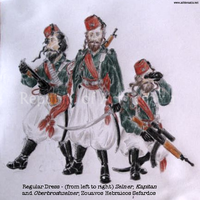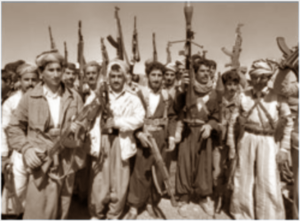Mahoz HaSephardim
| |||||
| Motto: unknown' | |||||
| Official languages | Ladino, Bukhori, Farsi | ||||
| Anthem | {{{Anthem}}} | ||||
| Capital | Nueva Sinagoga | ||||
| Largest city | Ladadika, Alcazar los Sefardos, Casa Ebraica | ||||
| Jajam Bashi of the Mahoz: | Musa Al-Harizi | ||||
| Premier | {{{Premier}}} ({{{PremierParty}}}) | ||||
The Mahoz HaSephardim (mahɒz hɑːsɛfɑːrdiːm) is an overseas territory of the Republic of Ashkenatza in north-western Eura. At the time of writing it borders Antica to the East, Babkha to the South, and is in close proximity to islands owned by Alexandria to the North and South-West. Its Hebrew name (it is today colloquially referred to as 'the Mahoz') means the 'Sephardic District', and it was after Babkha announced its transition from a micronation to community forum (later reversing this decision) that regions of north-western Eura were signed over to Ashkenatza officially by Hesam Shahanshah of Babkha on August 19th, 2009. This marked the start of Ashkenatzi expansion outside its metropolitan territories on the continent of Benacia and a closer relationship with Babkha. The Mahoz is today one of several Ashkenatzi territories outside Benacia (for example, the Mala'eretz in Keltia) and was originally envisaged as a Sephardic Jewish themed province, hence the adoption of Ladino as its regional language. Its capital is the city of Nueva Sinagoga and other large cities include Ladadika, Alcazar los Sefardos, and Casa Ebraica. From November 2009 to August 2010 a large number of coastal cities in what are now the Babkhan provinces of Norasht, Shahzamin, and Kelestan were ruled by Ashkenatza as the Mahoz Oriental. After the transfer of these territories to Babkha the remaining Mahoz lands are known as the Mahoz Occidental.
History
Beginnings
Babkha's gradual development in mid 2009 from an active micronation to a communal forum known as the 'Villainous Order of Babkhan Blackfriars'[1] found Ashkenatza in an excellent position, through its then military alliance with Babkha, the Rozenkhan Protocols (which was in part to thank for the ease of the Ashkenatzi annexation of Tellia that same year), to expand overseas onto the continent of Eura. Discussions between Ashkenatzi dignitaries and Hesam Shahanshah of Babkha had proved fruitful, and by August 2009 it had become known that Ashkenatza was to profit directly from what was to be a phased Babkhan reduction in stages from Eura, presumably so as to leave a Micras in which former Babkhan territory was in friendly hands. Amokolia was reportedly also considered as a recipient for Babkhan land at the time, though this was never realised. The first consignment of Babkhan land in a transfer to Ashkenatza was submitted to the MCS on August 19th, 2009[2], transferring portions of the Babkhan provinces of Alkhiva and Báatharz directly to Ashkenatzi sovereignty. Various names for this region were discussed by an extraordinary meeting of the Knesset, including a protectorate known as Mizraha, and even a colony, to be called Yonder Litovina. Hesam Shahanshah asked the Ashkenatzi government to protect the Babkhan heritage and culture of the regions claimed, making the vaguely defined idea of a Sephardic or Mizrahi region a diplomatic obligation. Thus, the Hebrew name Mahoz HaSephardim (roughly translating as Sephardic District) was decided upon and Ladino names chosen for its cities. The broadly Levantine culture which the Mahoz simulated was therefore seen as ideal in stressing a very much culturally Jewish region yet with a distinct and important Babkhan-Persian heritage.

By Babkha's departure from the MCS proper (then believed to be for good), Ashkenatza expanded the Mahoz HaSephardim into now unclaimed territories to the south to consolidate control over the vast, strategic river delta in Eura's north by laying claim to the Babkhan fortress of Khan-1, renamed Solomon-1 by the Ashkenatzi government. By this time, Antica had also claimed much of the former Báatharz region and a large cultural flowering of the area under the names of Saba and Jomuriya Êrânistânyâ (Republic of Eranistan) began. Further to Eura's east, Ashkenatza laid claim to large coastal areas and peninsulae in the former regions of Norasht, Shahzamin, and Kelestan[3], expanding the Mahoz and starting the distinction between the Mahoz Oriental and Mahoz Occidental. These strategic cities, including Nuevaselanik, Orta-Sfarad, and Alcazar Haketia, were interestingly located in a region Ashkenatza had entertained claiming many months before as their first land transfer from Babkha, though north-western Eura was settled on due to its easy access to Benacia and therefore the Metropolian territories of the Republic.
In November 2009 the first Jajam-Bashi of the Mahoz, Herschel Ziegler, was appointed thanks to an Executive Order from Nohsi Moshe Goltz which had elevated the territory to an autonomous status and firmly established the position of Jajam-Bashi and his council, the Casa Ejecutiva.[4] After the distaction of the Amokolian War in September and October, the remainder of 2009 was a period of quiet development for the region and Ashkenatza in general until the Draypintl Bagrif (otherwise known as the Three Point Plan) a document by Nohsi Goltz designed to reinvigorate Ashkenatza and reorganise its government, encouraged regional cultural development and a love of simulationism. This led to the creation of Development Towns in remote regions of the Mahoz to harness the area's extensive natural resources[5], and the creation of an indigenous fighting force, the Tercios Ladino de Zouave, spearheaded by then Feldmarshall P.E. ben Mavet. It was at this time that civil disturbances from Mahozi-based seccessionist organisations began to impact on the lives of Ashkenatzi citizens, later outlined in a comprehensive report on the cost of the Mahoz Insurgency which was to follow.[6]. These included but were not limited to attacks on rural development towns by notorious Mahozi brigand Yahya 'the bastard' ibn Yahya, a bomb in a hotel in Villa Levi, kidnapping of a local official and a prominent Sephardi Rabbi, and even indiscriminate explosions in cafes in Merenia and the Pale, in Metropolitan Ashkenatza. It was not long afterwards when the Foreign Ministry warned against all but essential travel to the Mahoz HaSephardim whilst Nohsi Goltz, enraged by the escalating violence, declared open war against the Mahoz insurgents on January 18th 2010.[7]
The Insurgency
| Mahoz Insurgency | |||||||
|---|---|---|---|---|---|---|---|
 Zurvanite Fedayeen Militia celebrate the 'tactical redeployment' of the Zoauves from Toledano |
|||||||
|
|||||||
| Belligerents | |||||||
Babkhi pirate groups |
|||||||
| Commanders and leaders | |||||||
| Herschel Ziegler Pachad Emet ben Mavet Szhmuel Astopov Moshe Goltz Gideon Perez | Khan Mellah Khan Yahya ibn Yahya Mukhtar Ibrahim Ramidi |
||||||
| Units involved | |||||||
| Taskforce Retribution 4th, 5th, 6th Landvekhner Teyln (inf.) 1st Komando-Teyl (ASCMU) Tercios Ladino de Zouave: Brigada Moscardó, Bahamonde & La Pasionara | |||||||
On January 17th 2010 the Feldmarshall of the Republic reported heightened civil unrest in the Alkhivan city of Nueva Sinagoga, where civil unrest had turned violent and angry mobs had started attacking the Sephardic Zouave regiments stationed in the region. Babkhan pirate 'motherships' were reported heading northwards from the ruined Babkhi port of Bushehr to the Mahoz proper, and by the evening of the 18th the cities of Toledano and Villa Levi were under a massive assault from Babkhan pirate vessels, whose troops began ransacking civic offices and looting shops- all attempts to contact the remote fortress of Solomon-1 had failed and the lines of the main Zouave regiment, Brigada La Pasionara, had been broken by Fedayeen forces to the south. Meanwhile, Operation Restore Honour was being drafted by Ashkenatzi command, a combined military assault on the Mahoz and a targeted assassination of local Mahoz shipping magnate Solomon Hayyim-Yacoubi, engineered to appear as the work of one of the Mahoz Babkhan warlords Yahya 'the Bastard' ibn Yahya or Khan Mellah Khan. The plan was then to turn the entire provincial ruling classes of the Mahoz against the new warlord occupiers and initiate a grassroots uprising against them. However, military action with the 2nd Ashkenatzi Division and ASCMU detachments under Gyeneral Szhmuel Astopov was deemed more prudent and outgoing Nohsi Moshe Goltz declared Khan and his compatriots 'rag-tag brigand scum'. Operation Restore Honour was a success, crushing insurgent forces with superior air power and alleged Antican support. On January 25th, Jajam-Bashi Herschel Ziegler officially declared the insurgency over, with ASCMU corps under Gideon Perez apprehending Khan and ibn Yahya after a firefight in a small coastal town in the Mahoz, aided by colourfully named local magnate Jenaab Abu Ilyas Eskandar al-Aziz al-Karim al-Rashid ibn Haroun ibn Musa al-Karim ibn Zakhariya ibn Ardeshir Khan Mirza Abdul Shah Kamalshahri, Sarlashkar of the Gârd e Jâvidân, Defender of the Harem Orchards and Holder of the Keys of the Six Golden Cabinets of the Shah’s Bedchamber. In one of the first instances of the Ashkenatzi Judiciary being enacted, a Bill of Attainder was issued for the prosecution of Khan Mellah Khan, closing an interesting chapter in Ashkenatza's history on Eura and serving as a useful milestone in the development of Ashkenatza's armed forces.
The Mahoz today
Politics
Under Article III Ashkenatza's Territorial Classification Bill[8] of September 2010 the Mahoz HaSephardim is defined as an autonomous region, essentially meaning that it is administered by an executive agent appointed by the Nohsi who has internal economic, legislative, and judicial powers subordinate to those of the Republic's central government in Kolmenitzkiy and therefore a degree of autonomy to develop the region at his or her own pleasure. The Mahoz was until November 2009 a directly administered territory and though Nohsi M. Goltz first declared its autonomy that same month[9] the exact limits of Mahoz governance remained not yet fully defined until the aforementioned bill of September 2010.
The nominal head of the Mahoz is known as the Jajam-Bashi- named after the Haham-Bashi of the Turkish Sephardic Community under Ottoman Rule. The name carries religious connotations to observant Jews, much like the positions of Dayan and Nohsi on the State level of government in Ashkenatza, and as such can be seen as a traditional Sephardic leadership role which creates greater cohesion and a sense of ethnic identity for inhabitants of the Mahoz.
Goltz's Nohsi Order II on the subject of the region's autonomy named this executive agent of the Mahoz the Jajam-Bashi (חכם באשי - hɑːχɑːm bɑːʃɪ), after the macronational Sephardic title, who resides in Nueva Sinagoga with his regional semi-autonomous executive assembly, the Casa Ejecutiva. Neither the Jajam-Bashi nor the Casa Ejecutiva have any role in the military and diplomatic business of the Mahoz HaSephardim, nor do they have the right to pass executive orders which contravene the central Ashkenatzi legislature in Kolmenitzkiy, the Knesset. The Jajam-Bashi enters into either of these roles entirely at the Nohsi's pleasure and generally works on internal economic, political, and cultural development of the province, and his internal executive orders may be anulled by order of the Nohsi or Knesset. The Jajam-Bashi is directly appointed by the Nohsi and may nominate a successor for the Nohsi to approve. The First Jajam-Bashi of the Mahoz was Herschel Ziegler, appointed in November 2009[10]. The second, Amir Rabin was appointed by Nohsi ben Mavet in May 2010[11], whilst the third and incumbent Jajam-Bashi is Musa Al-Harizi, appointed by Nohsi Zalmanov in January 2011.[12].
Culture
References
- ^ http://babkha.com/forum/viewtopic.php?t=8174
- ^ http://hub.mn/forum/viewtopic.php?f=6&t=3608
- ^ http://hub.mn/forum/viewtopic.php?f=6&t=3856&p=52065
- ^ http://ashkenatza.net/phpBB3/viewtopic.php?f=49&t=808
- ^ http://ashkenatza.net/phpBB3/viewtopic.php?f=58&t=909
- ^ http://ashkenatza.net/phpBB3/viewtopic.php?f=6&t=1190
- ^ http://ashkenatza.net/phpBB3/viewtopic.php?f=65&t=970
- ^ http://ashkenatza.net/phpBB3/viewtopic.php?f=21&t=1661&start=0
- ^ http://ashkenatza.net/phpBB3/viewtopic.php?f=49&t=808
- ^ http://ashkenatza.net/phpBB3/viewtopic.php?f=58&t=826
- ^ http://ashkenatza.net/phpBB3/viewtopic.php?f=49&t=1228
- ^ http://ashkenatza.net/phpBB3/viewtopic.php?f=33&t=1956




